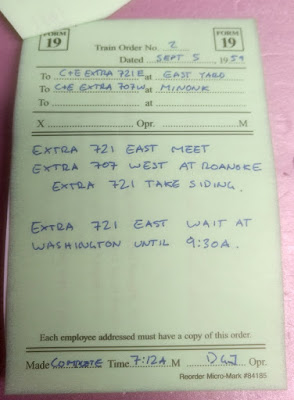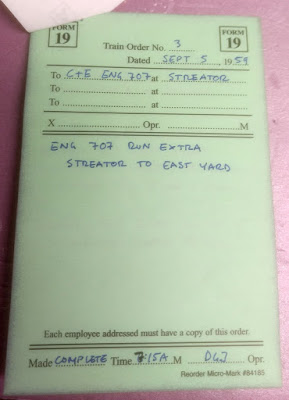As is often the case, during Op Session 5 there were too many eastbound freight cars in Pekin at the end of the day for
#50 to haul, requiring us to call an extra train. Today we will follow the operation of extra train 2101 east, which will handle local work in Morton, Crandall, Washington, and Roanoke, along with a few cars bound for staging (Streator).
As an extra train, extra 2101 east has lower priority than any 1st or 2nd class train on the schedule. We receive our clearance card and train orders from the dispatcher at 3:40pm. We have one train order, #5, which reads "Eng 2101 run extra east yard to Streator". This is about as simple as train orders get, with no time restrictions and no mention of other extras. We only have to worry about dodging scheduled trains.
 |
| Clearance Form A, indicating we have one train order, #5. |
 |
| Train order #5, authorizing us to run extra from East Yard in Pekin, IL to Streator, IL. |
We look at the timetable to determine what trains we need to stay out of the way of.
 |
| ATSF Pekin branch timetable |
Looking at the eastward register at East Yard we see that all departing trains have already left, with the latest one,
#50, having left just 10 minutes ago at 3:30pm.
 |
| Eastward register at East Yard in Pekin, IL. |
Looking at the westward register (not pictured) we see that two scheduled trains,
#13 and
#49, have not yet arrived.
#13 is scheduled to arrive in Pekin at 4:15pm, leaving the previous town, Morton, at 4:00pm. With it now being 3:45pm there is no way we can complete a brake test and make it to Morton in time. So we must wait for
#13 to go past East Yard. We'll use the time to review our car cards and write up our switch list for the local work that needs to go on along the route.
 |
| Paperwork for extra 2101 east. Car cards, Clerance form A, train order, and switchlist |
 |
| Extra 2101 east, with 9 cars, waiting on the departure track at East Yard in Pekin, IL. |
The
Pekin Chief #13 rolls through East Yard at 4:12pm, just in time for a 4:15pm arrival in Pekin.
 |
| The Pekin Chief #13 rolls through East Yard |
Looking at the
timetable we see that the next scheduled train,
#49, isn't scheduled to arrive at East Yard until 6:20pm, and leaving the previous town of Morton at 6:00pm. This gives us plenty of time to get to Morton and do some work. We depart East Yard toward Morton at 4:15pm. We sign the register with our information: Train x2101 east, engine 2101, white flags (indicating extra), train order #5, departing 4:15pm, 9 cars, conductor DGJ.
 |
| We add our train to the eastaward register at East Yard in Pekin, IL as we depart. |
We arrive in Morton at 4:30pm, and as the lower priority train we take the siding.
 |
| Taking the siding in Morton, IL |
We still have time to do some switching before needing to clear the main for
#49. Looking at our switchlist we have 5 deliveries in Morton.
- CIM 11018 with coal for Libby McNeil.
- FGEX 35288 empty for Libby McNeil.
- WM 7020 TOFC for the TOFC ramp.
- ATSF 89989 TOFC for the TOFC ramp.
- NYC 436643 with parts for Morton Meyer.
We then have 2 pickups and 1 move in Morton.
- PRR 19103 from Morton Meyer with parts for the Illinois Terminal interchange in Morton.
- AESX 195 from Illinois Terminal interchange with corn syrup for ATSF staging.
- MILW 50105 from Libby McNeill with canned pumpkin for ATSF staging.
We use the card sorting shelf to help visualize the work that needs to occur, and update our switchlist.
 |
| Sorting car cards to determine work that needs to take place in Morton |
 |
| Updated switchlist |
We end up having to pull and shuffle several cars from Libby McNeill to get our newly delivered cars to the right spots.
 |
| Switching Libby McNeill cannery in Morton, IL. |
Next we deliver the trailers to the TOFC ramp.
 |
| Morton had a TOFC ramp that saw a fair bit of traffic. |
At 5:40pm we head back to the siding to clear the main for
#49, which is scheduled to arrive at Morton at 6:00pm. At 6:10pm
#49 arrives. With no pickups or deliveries in Morton,
#49 quickly gets moving towards East Yard.
 |
| #49 rolls through town as we wait in the siding. |
It is 6:20pm and we are delivering a boxcar to Morton Meyer. Next we deliver a boxcar to the Pennsylvania Railroad interchange, and pickup a tank car from the Illinois Terminal interchange.
 |
| Working the IT and PRR interchanges in Morton. After 1955 the IT ran on the PRR's line through town after abandoning their own trackage running down the middle of a nearby parallel street. |
At 7:10pm we have our train coupled up, brake tested, and ready to depart for Washington. With there being no more scheduled trains for the day, and no train orders received notifying us of other extra trains on the line, we can safely head to Washington.
 |
| Extra 2101 east ready to depart Morton, IL |
At 7:30pm we arrive in Washington. We have one pickup.
 |
| Arriving in Washington, IL. |
At 7:43pm we depart Washington.
At 7:50pm we enter trackage rights on the Toledo Peoria & Western at Pekin Jct.
At 8:15pm we arrive in Roanoke. We take the main as we know that no scheduled trains remain today, and have received no train orders informing us of extra trains. We inspect car cards to update our switchlist.
 |
| Inspecting car cards in Roanoke, IL. |
We have 3 deliveries in Roanoke.
- ATSF 31595 with dried distillers grains for Eureka Milling.
- ATSF 148595 with wheat middlings for Eureka Milling.
- CIM 11047 with coal for Roanoke Farmers Co-op.
We have 1 pickup in Roanoke.
- NKP 8081 from Prairie Dehydrating with bagged alfalfa feed for ATSF staging.
 |
| Picking up NKP 8081 loaded with bagged alfalfa feed pellets at Prairie Dehydrating. |
Main street in Roanoke crosses the railroad. We have to break the train to avoid blocking traffic while we switch the town.
 |
| Main street crossing in Roanoke, IL |
At 8:55pm we have completed our switching in Roanoke, have coupled back up, and brake test is completed. We depart for staging and terminate there.
As can be seen from our switchlist we delivered 10 cars, and entered ATSF staging with 5 cars in our train.
 |
| Switchlist at the end of our run. 10 delivered cars, and 5 cars still on the train as we entered staging. |
































